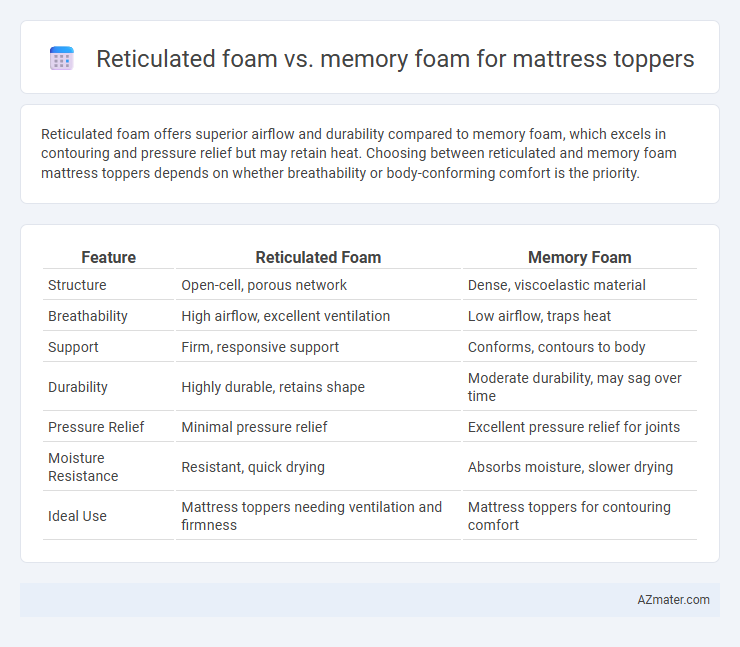Reticulated foam offers superior airflow and durability compared to memory foam, which excels in contouring and pressure relief but may retain heat. Choosing between reticulated and memory foam mattress toppers depends on whether breathability or body-conforming comfort is the priority.
Table of Comparison
| Feature | Reticulated Foam | Memory Foam |
|---|---|---|
| Structure | Open-cell, porous network | Dense, viscoelastic material |
| Breathability | High airflow, excellent ventilation | Low airflow, traps heat |
| Support | Firm, responsive support | Conforms, contours to body |
| Durability | Highly durable, retains shape | Moderate durability, may sag over time |
| Pressure Relief | Minimal pressure relief | Excellent pressure relief for joints |
| Moisture Resistance | Resistant, quick drying | Absorbs moisture, slower drying |
| Ideal Use | Mattress toppers needing ventilation and firmness | Mattress toppers for contouring comfort |
Introduction to Mattress Topper Materials
Reticulated foam offers a highly breathable structure with an open-cell design that enhances airflow and moisture wicking, making it ideal for hot sleepers. Memory foam, known for its viscoelastic properties, contours closely to the body for pressure relief and support, yet often retains heat due to its dense composition. Choosing between reticulated and memory foam depends on prioritizing cooling ventilation versus adaptive comfort in mattress topper materials.
What is Reticulated Foam?
Reticulated foam is a highly porous, open-cell material designed for superior breathability and airflow compared to memory foam, making it ideal for mattress toppers that require enhanced ventilation and moisture-wicking properties. Unlike memory foam, which contours to the body and retains heat, reticulated foam's open structure promotes cooling and prevents heat buildup, contributing to a more comfortable sleep environment, especially in warm climates. Its durability and quick-drying features also make reticulated foam a favorable choice for mattress toppers in settings where hygiene and moisture management are priorities.
Understanding Memory Foam
Memory foam is a viscoelastic material known for its ability to conform to body shape, providing targeted pressure relief and support by responding to heat and weight. Unlike reticulated foam, which features an open-cell structure for enhanced airflow and rapid drying, memory foam offers slower recovery time and superior contouring that improves spinal alignment during sleep. This makes memory foam ideal for those seeking personalized comfort and reduced motion transfer in a mattress topper.
Key Differences: Reticulated vs Memory Foam
Reticulated foam features an open-cell structure that promotes superior airflow and rapid moisture dissipation, making it ideal for hot sleepers and environments requiring breathability. Memory foam offers dense viscoelastic properties that contour closely to the body, providing pressure relief and motion isolation but can retain heat. The primary difference lies in reticulated foam's enhanced ventilation and durability versus memory foam's conforming comfort and thermal retention.
Breathability and Airflow Comparison
Reticulated foam features an open-cell structure that enhances breathability and maximizes airflow, making it ideal for mattress toppers in warm climates or for hot sleepers. Memory foam, while providing excellent contouring and pressure relief, tends to trap heat due to its denser composition, resulting in reduced ventilation and potential discomfort. Choosing reticulated foam over memory foam significantly improves mattress topper airflow and temperature regulation.
Comfort and Support Characteristics
Reticulated foam offers superior breathability and firm support due to its open-cell structure, promoting airflow and temperature regulation for a cooler sleep experience. Memory foam excels in pressure relief and contouring, adapting to body shape while providing cushioned comfort that reduces pressure points and enhances spinal alignment. Choosing between the two depends on whether the priority is a cooler, more supportive surface or a softer, body-conforming feel.
Durability and Longevity
Reticulated foam offers superior durability compared to memory foam, maintaining its structural integrity and resilience even under frequent use due to its open-cell design that promotes airflow and prevents collapse. Memory foam provides excellent comfort by contouring to the body but tends to degrade faster, often developing permanent indentations and losing support over time. Choosing reticulated foam for a mattress topper ensures longer-lasting performance and sustained firmness, making it ideal for those seeking durability and extended lifespan.
Maintenance and Cleaning Ease
Reticulated foam mattress toppers offer superior breathability and quick drying, making maintenance and cleaning easier by reducing moisture retention and minimizing mold growth. Memory foam toppers, while providing excellent body contouring, tend to absorb moisture and odors, requiring more frequent deep cleaning and slower drying times. Regular vacuuming and spot cleaning with mild detergent are recommended for both types to maintain hygiene and prolong mattress topper lifespan.
Ideal Use Cases for Each Foam Type
Reticulated foam is ideal for mattress toppers in hot climates or for users who require enhanced airflow and moisture control due to its open-cell structure promoting breathability. Memory foam suits those needing pressure relief and body contouring support, making it perfect for individuals with joint pain or sensitivity seeking comfort and spinal alignment. Choosing between reticulated foam and memory foam depends on sleep temperature preference and targeted therapeutic benefits.
Choosing the Right Mattress Topper for You
Reticulated foam offers superior breathability and durability, making it ideal for hot sleepers or those needing enhanced airflow. Memory foam contours closely to the body's shape, providing excellent pressure relief and motion isolation, preferred by side sleepers or individuals with joint pain. Selecting the right mattress topper depends on your sleep style, temperature preferences, and desired support level to ensure optimal comfort and restful sleep.

Infographic: Reticulated foam vs Memory foam for Mattress topper
 azmater.com
azmater.com